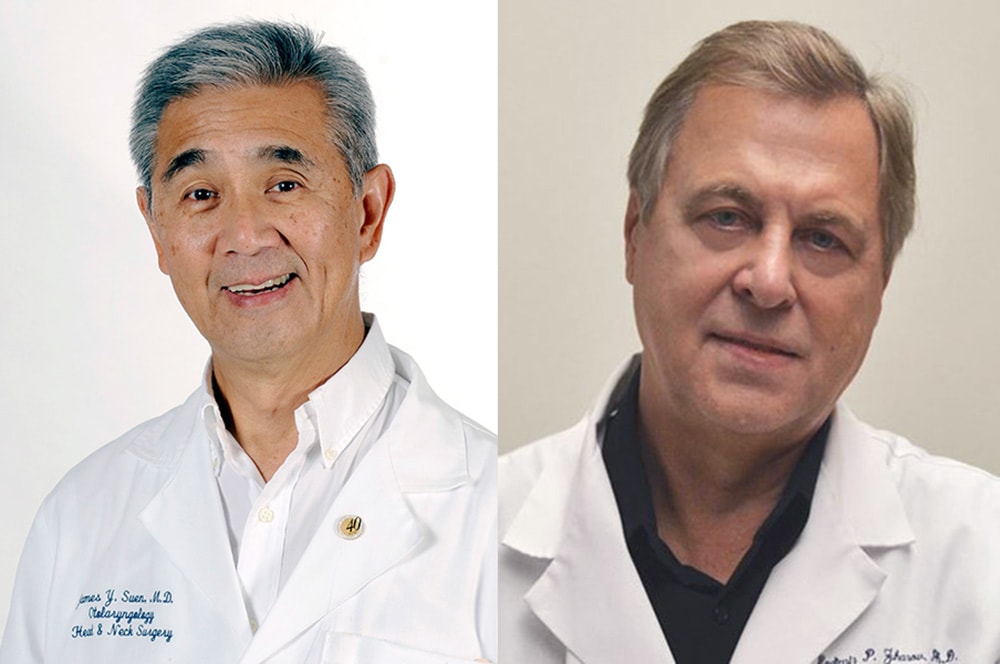UAMS Researchers Publish Advances in Use of Noninvasive, Miniature Laser-Based Blood Scanner for Disease Identification
| A University of Arkansas for Medical Sciences (UAMS) research team has published new advances in its ability to detect cancer, infections and other medical conditions using a portable blood sensor that does not require needles or other invasive methods.
Scientific Reports, a Nature Portfolio journal, published the work led by UAMS’ Vladimir Zharov, Ph.D., D.Sc., titled, “Towards Rainbow Portable Cytophone with Laser Diodes for Global Disease Diagnostics.”
The smaller, less expensive device uses a miniature array of lasers and sound waves to scan blood as it travels through the vessels in the arm. The latest advance, in a collaboration with the University of Arkansas at Little Rock (UALR) and Yale School of Public Health, builds on Zharov’s patented Cytophone platform.
The team showed that a smaller, portable device using the Cytophone technology can identify white and red blood clots, melanoma cells with melanin and malaria with hemozoin nanocrystals as key disease biomarkers.
“Our latest findings demonstrate that a highly accurate portable device is achievable, which is especially significant for resource-poor countries fighting diseases like malaria,” said Zharov, a professor in the College of Medicine Department of Otolaryngology – Head and Neck Surgery, and director of the Arkansas Nanomedicine Center. “This was made possible by exciting breakthroughs in laser diode and digital technologies for counting the acoustic signals from individual biomarkers at different wavelengths for identification of diseases with different spectral fingerprints.”
UAMS’ James Y. Suen, M.D., a co-author, said publication of these results will help with further collaborative interest in the team’s development and application of Cytophone.
“We are gratified to see this exciting technology published, and we look forward to continued excellent results of our ongoing and future research with Cytophone,” said Suen, a distinguished professor, surgeon and former director of the then-Arkansas Cancer Research Center, now the Winthrop P. Rockefeller Cancer Institute. “Someday, we believe this technology with small cost-effective lasers will translate to a wearable device the size of a smartwatch or bracelet.”
To identify abnormal cells as they circulate through the body, the Cytophone deploys its array of multicolor lasers directed at veins or arteries near the wrist. The light absorption by passing abnormal cells leads to thermoacoustic generation of acoustic waves detected with small ultrasound transducers attached to the skin.
“Cytophone is literally listening to the laser-activated sound from circulating cells,” Zharov said.
The device marries the latest laser technology, nanotechnology, photoacoustic effect and flow cytometry. The photoacoustic effect occurs when cells absorb the light from laser beam pulses, creating ultrasound waves. Flow cytometry is the laser-based technique used to analyze the properties of fast flowing cells.
If proven effective in ongoing clinical trials, Cytophone could potentially be used as a supplement to conventional blood sampling methods.
“More work needs to be done, but the progress in laser diodes with color numbers higher than in the natural rainbow spectrum make this a promising technology for the identification of different malaria strains,” said Sunil Parikh, M.D., MPH, associate professor of epidemiology at Yale University.
Suen and Zharov established the spinoff company, CytoAstra LLC, through BioVentures LLC at UAMS, to commercialize the patented Cytophone platform initially for detection of circulating melanoma cells.
In addition to Zharov and Suen, co-authors on the Scientific Reports publication are (in alphabetical order):
- Jillian Armstrong, Ph.D., student, Yale School of Public Health
- Alex Biris, Ph.D., professor and chief scientist at the Center for Integrative Nanotechnology Sciences, UALR
- Hind Jawad, Ph.D., Center for Integrative Nanotechnology Sciences, UALR
- Yulian Menyaev, Ph.D., research associate, Arkansas Nanomedicine Center, UAMS (biomedical engineer)
- Dmitry Nedosekin, M.D., Ph.D., medical resident, research associate professor, Arkansas Nanomedicine Center, UAMS
- Parikh, M.D., MPH, associate professor of epidemiology, Yale School of Public Health (malaria expert)
- Mustafa Sarimollaoglu, Ph.D., College of Medicine Department of Otolaryngology, UAMS (digital health software development).
- Jason Stumhofer, Ph.D., associate professor, College of Medicine, Department of Microbiology and Immunology, UAMS (malaria expert)
- Aayire Yadem, Ph.D., student, Center for Integrative Nanotechnology Sciences, UALR
- Fumiya Watanabe, Center for Integrative Nanotechnology Sciences, UALR
